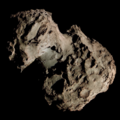 Simulated orbit of C/1992 J1 (Spacewatch) as of 12 January 2012 | |
| Discovery [1] | |
|---|---|
| Discovered by | David Rabinowitz Spacewatch Project |
| Discovery site | Kitt Peak Observatory |
| Discovery date | 1 May 1992 |
| Designations | |
| 1992h [2] 1993 XV | |
| Orbital characteristics [3] [4] [5] | |
| Epoch | 3 August 1993 (JD 2449202.5) |
| Observation arc | 1,007 days (2.76 years) |
| Number of observations | 240 |
| Aphelion | ~75,000 AU (inbound) ~3,700 AU (outbound) |
| Perihelion | 3.007 AU |
| Eccentricity | 0.99996 |
| Orbital period | ~78,000 years (outbound) |
| Inclination | 124.32° |
| 203.32° | |
| Argument of periapsis | 83.40° |
| Last perihelion | 6 September 1993 |
| TJupiter | –1.212 |
| Earth MOID | 2.541 AU |
| Jupiter MOID | 0.127 AU |
| Comet total magnitude (M1) | 8.3 |
| Comet nuclear magnitude (M2) | 14.2 |
C/1992 J1 (Spacewatch) is a comet that was discovered 1 May 1992 by David Rabinowitz of the Spacewatch Project. This was the first comet to be discovered using an automated system. [1]

